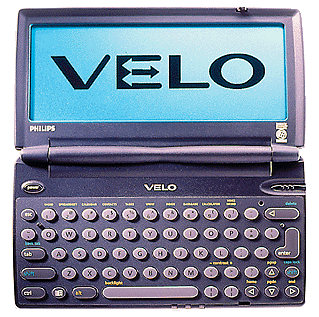Philips Velo 500
A completely new Velo, or just a
sequel?

Remember Die Hard II? It was the same cop (Bruce
Willis), in the same time of year (Christmas), but this time the terrorists seized an
airport instead of a building. It mimicked the first Die Hard movie in almost every way
and moviegoers still loved it. It was the calculated commercial success that everyone
expected it to be. Now Philips is hoping for the same blockbuster conquest with the Velo
500, the sequel to their incredible Velo 1.
The first, and most obvious, change is the name. Philips jumped the second generation
device 499 iterations in order to make the naming convention extendible in both
directions. Smaller platforms or systems with reduced feature sets will earn designations
below 500, and enhanced systems will earn higher numbers. The naming method, while far
less seductive, follows the PC model of--you get what you pay for--in ascending model
numbers. Plus, it makes a very clear point: Philips knows that there are many different
form factors and configurations for an HPC and they're going to fill as many of them as
possible.
While the changes in the unit are few, they are certainly worthy of mention. Of foremost
importance, Philips has become a follower in one category: the screen. Philips is moving
up to HP's 640x240 screen size to satisfy their user's number one request: better
readability. But to get ahead of the pack, Philips has boosted their processor to 75MHz,
more than double the processing speed of the Velo 1 which surpassed every other HPC by a
huge margin in our previous tests. And Philips is doubling the memory too, offering 8MB
and 16MB configurations to satisfy Windows CE 2.0 requirements and memory hungry users.
The internal soft modem's speed has also been upgraded to 28.8 Kbps to provide users with
a faster Web experience without any detectable loss in battery life.
Externally, the backlight switch has been relocated to the side of the device and the
phone port has moved to the back of the unit. As if to prove that the modem jack placement
doesn't belittle the importance of communication, the Velo 500 supports fax receive as
well as send capabilities. The ten QuickStart application keys that adorn the top of the
Velo are now programmable. Philips also says that external VGA support will be provided
via a connection through the proprietary V-module.
But thankfully, Philips promises that each Velo will have the same signature Euro-sleek
styling as its flagship model. The surfboard design and stylish indentation across the
front of the unit will be carried on in whatever form the Velo may take. Also like its
predecessor, the Velo 500 comes with an AC adapter and a docking station.
Philips, always the customer-oriented company, has gone out of its way to support its
current customer base. Offering the longest free CE 2.0 upgrade program (for users who
purchased a Velo 1 after August 1st) and a RAM upgrade incentive ($49.99 for a 4MB upgrade
when purchased with the Velo 1), Philips is making the path to CE v2.0 as painless as
possible.
The Velo 1 was created with a very clear vision: Target a segment of the business
community and give them the most feature packed HPC available, in a stylish, functional
unit. And the success of the first device shows the wisdom of Philips' choice. The Velo
was the leader and the product-to-beat in the first generation of Windows CE devices.
But with success comes imitation. Windows CE 2.0 has built-in support for voice recording
and every one who has even heard of Windows CE knows that a built-in modem and microphone
are quickly becoming standard issue. Philips' research shows that the modem is the number
one reason people select the Velo and as Robert Brown, Director of Marketing says, people
think "that voice memo thing is cool, too."
Can Philips survive using the same formula as last year's model? Or is the Velo 500 just a
temporary bridge to the future? Philips has stated that they are very eager to release a
color device, but not at the expense of battery life or readability. Once they can obtain
a satisfactory balance between color and battery life, we can expect a world of color from
the Philips Mobile Computing Group. But, when asked about other form factors, Brown said,
"The Pilot does a pretty good job, and I'm not stupid; I'll go where the money
is." He smiles as he adds, "1998 is going to be a good year for us, I guarantee
it!"
The Velo 500 will be available in 8MB (US$699.99) and 16MB (US$839.99) devices and should
begin shipping the beginning of January.
- Dan Hanttula
Philips Electronics <velo.philips.com>
|




